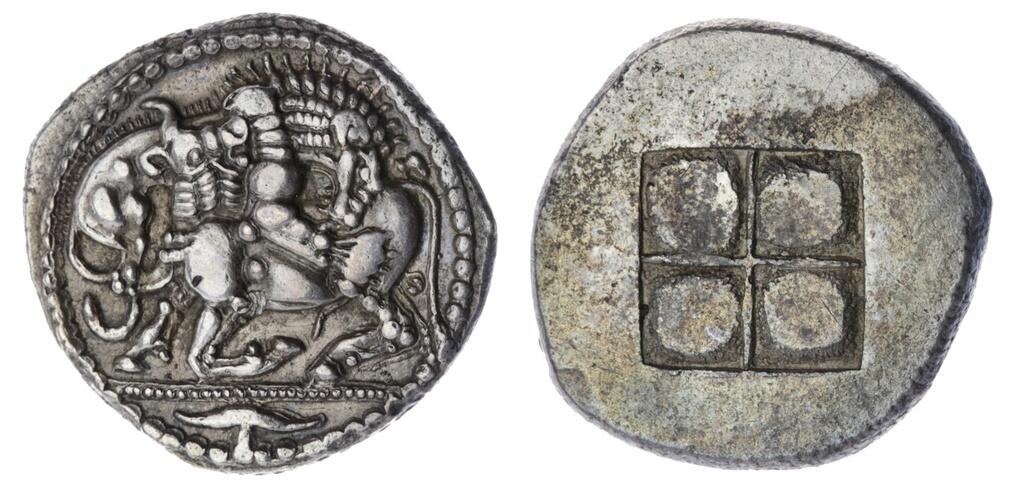AC 146 - Acanthus, silver, tetradrachms (510-465 BCE) Desneux
From SILVER
510 BCE - 465 BCE Silver 102,935 kg
Description
| ObverseInscription or printing placed on the obverse.: | Lion right attacking Bull left and biting into its rear, acanthus leaf below beaded exergual line |
| ReverseInscription or printing placed on the reverse.: | Quadripartite incuse square |
Mint and issuing power
| MintIdentifies the place of manufacture or issue of a numismatic object.: | Acanthus | Ancient regionAncient region.: | Macedon | Modern countryModern country: Greece | AuthorityIdentifies the issuing power. The authority can be "pretended" when the name or the portrait of X is on the coin but he/she was not the issuing power. It can also be "uncertain" when there is no mention of X on the coin but he/she was the issuing power according to the historical sources: |
Chronology
| FromIdentifies the initial date in a range assigned in a numismatic context. | 510 BCE | toIdentifies the final date in a range assigned in a numismatic context.. | 465 BCE | PeriodTime period of the numismatic object.: Archaic until 480 BC |
Physical description
| MetalThe physical material (usually metal) from which an object is made.: | Silver |
Median weightMedian of the weights of numismatic objects (in grams). in grams | 17.00 | DenominationTerm indicating the value of a numismatic object. Examples: tetradrachm, chalkous, denarius.: | tetradrachm |
StandardStandard.: |
Image

AC146 Acanthus.jpg [1]
References
| Die study referencePublication of the study: | Desneux 19491Desneux 1949, n° 1-92 | ||
| Coin series referenceReference to coin series study: | Sear I2Sear I, n° 1270-1272, 1362-1363, RQEMAC3RQEMAC, n° 146, HGC 3.14HGC 3.1, n° 385 | ||
Obverse dies distribution
| FrequencyFrequency of specimen in distribution. ᵖ | Number of obversesNumber of obverse dies. ᵖ (o) | % (o) | Number of coinsNumber of coins. (n) | % (n) | Die nameName(s) of the die(s). |
| 1 | 77 | 83.7 | 77 | 63.64 | 1bis, 3, 8, 9, 12, 13, 15, 16, 17, 18, 19, 20, 21, 22, 23, 24, 25, 26, 27, 28, 29, 30, 31, 32, 33, 34, 35, 36, 38, 39, 39bis, 40, 41, 41bis, 42, 43, 46, 47, 48, 49, 50, 51, 53, 54, 55, 56, 57, 58, 59, 60, 61, 62, 63, 64, 65, 66, 67, 68, 69, 70, 71, 72, 73, 74, 75, 76, 77, 78, 79, 80, 81, 82, 83, 85, 86, 87, 88 |
| 2 | 7 | 7.61 | 14 | 11.57 | 1, 7, 11, 14, 37, 52, 89 |
| 3 | 5 | 5.43 | 15 | 12.4 | 5, 6, 10, 45, 84 |
| 4 | 1 | 1.09 | 4 | 3.31 | 4 |
| 5 | 1 | 1.09 | 5 | 4.13 | 2 |
| 6 | 1 | 1.09 | 6 | 4.96 | 44 |
| Total | 92 of 92 | 100.01 | 121 of 121 | 100.01 |
Reverse dies distribution
no distribution is available
Quantification
| Number of obversesNumber of obverse dies. ᵖ (o) | 92 | Number of singletons (o1)The number of singleton coins. ᵖ | 77 |
| Number of reverse diesNumber of reverse dies. (r) | 82 | Number of coinsNumber of coins. (n) | 121 |
| Coins per obverse dieNumber of coins per obverse die. (n/o) | 1.32 | Coins per reverse dieNumber of coins per reverse die. (n/r) | 1.48 |
| Reverse per obverse ratioRatio of obverse dies divided by reverse dies. (r/o) | 0.89 | Percentage of singletons (o1)number of coins (n) divided by the number of singletons (o1) ᵖ | 83.7 % |
| Original number of dies (O) (Carter 1983 formula)The estimation of the number of coins according to Carter 1983 ᵖ | 302.75 | Coins struck if 20,000 as average productivity per dieCoins made if the average productivity for obverses (according to Carter) is 20,000. ᵖ | 6,055,000 |
| Original number of dies (O) (Esty 2011 formula)The estimation of the number of coins according to the singleton formula in Esty 2011 ᵖ (O) | 383.86 | Survival rate if 20,000 as average productivity per dieSurvival rate if average productivity is 20,000. ᵖ | 0.00002 |
| Coverage (o = % of O) (Esty 1984 formula)Esty 1984 - coverage (% of O) ᵖ (o = % of O) | 36.36% | Die productivity if survival rate 1/2,000Average productivity if survival rate is 1/2,000. ᵖ | 799.34 |
| Weight of silver (in kg) if 20,000 coins per die (O = Carter formula)Carter 1983 * Median weight * 20000 (*10 if gold or electrum) ᵖ | 102,935 kg <br /> 102,935 kg | Die productivity if survival rate 1/5,000Average productivity if survival rate is 1/5,000. ᵖ | 1,998.35 |
Remarks
References
- ^ Desneux, Jules (1949), "Les tétradrachmes d’Akanthos", Revue Belge de Numismatique, 95, p. 5-122, pl. 1-38.
- ^ Sear, David R. (1978), Greek coins and their values. Vol. I, Europe, London, xl, 316 p.
- ^ Callataÿ, François de (2003), Recueil quantitatif des émissions monétaires archaïques et classiques, Numismatique Romaine, Wetteren, VII + 267 p.
- ^ Hoover, Oliver D. (2016), Handbook of coins of Macedon and its neighbors. 3. Part I: Macedon, Illyria, and Epeiros, sixth to first centuries BC, Lancaster, 437 p.